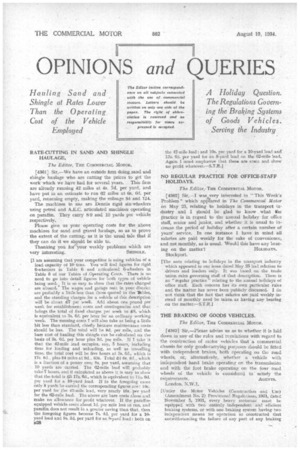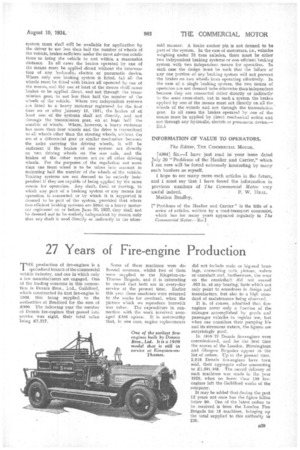OPINIONS and QUERIES RATE-CUTTING IN SAND AND SHINGLE HAULAGE.
Page 38

Page 39

If you've noticed an error in this article please click here to report it so we can fix it.
The Editor, THE COMMERCIAL MOTOR.
[4361] Sir,—We have an outside firm doing sand and shingle haulage who are cutting the prices to get the work which we have had for several years. This firm are already running 42 miles at 45. 7d. per yard, and have put in an estimate to run 62 miles at Os. 6d. per yard, returning empty, making the mileage 84 and 124.
The machines in use are Dennis rigid six-wheelers using petrol and A.E.C. articulated machines operating on paraffin. They carry 8-9 and 10 yards per vehicle respectively.
Please give us your operating costs for the above machines for sand and gravel haulage, so as to prove the extent of the cutting, as it is the usual tale that if they can do it we should be able to.
Thanking you foe'ryour weekly problems which are
very interesting. SHINGLE.
[I am assuming that your competitor is using vehicles of a load capacity of 10 tons. You will find figures for rigid 6-wheelers in Table 6 and articulated 6-wheelers in Table 8 of our Tables of Operating Costs. There is no need to go into detail figures for both types of vehicle being used. It is so easy to show that the rates charged are absurd.' The wages and garage rent in your district are probably a little less than those quoted in the litibles, and the standing charges for a vehicle of this description will be about £7 per week. Add about one pound per week for establishment costs and contingencies and that brings the total of fixed charges per week to £8, which is equivalent to 3s. 6d, per hour for an ordinary working week. The running costs I will also take as being a little bit less than standard, chiefly because maintenance costs should be less. The total will be 9d. per mile, and the bare cost of hauling this shingle can be calculated on the basis of 3s. 6d. per hour plus Od. per mile. If I take it that the 42-mile lead occupies, say, 5 hours, including time for loading and unloading, as well as travelling time, the total cost will be five hours at 8s. 611., which is 17s. 6d., plus 84 miles at 9d., 63s, Total £4 Os. 6d., which is a fraction of a penny over 8s. per yard, assuming that 10 yards are carried. The 62-mile lead will probably take 7 hours, and if calculated as above it is easy to show that the total is £5 17s. 6d., which is equivalent to 11s. 9c1. per yard for a 10-yard load. If in the foregoing cases only 8 yards be carried the corresponding figures are: 10s. per yard for the 42-mile lead, very nearly 15s. per yard for the 62-mile lead. The above are bare costs alone and make no allowance for profit whatever. If the paraffinequipped vehicle costs about id. per mile less to run, and paraffin does not result in a greater saving than that, then the foregoing figures become 7s. 4d. per yard for a 10yard load and 9s. 3d. per yard for an 8-yard load : both on 1328
the 42-mile lead; and 10s. per yard for a 10-yard load and 12s. 6d. per yard for an 8-yard load on the 62-mile lead. Again I must emphasize that these are costs and show no profit whatever.—S.T.R.]
NO REGULAR PRACTICE FOR OFFICE-STAFF HOLIDAYS.
The Editor,. THE COMMERCIAL MOTOR.
[4362] Sir,—I waszery interested in "This Week's Problem" which appeared in The Commercial Motor on May 25, relating to holidays in the transport industry and I should be glad to know what lolle practice is in regard to the annual holiday for office staff, senior and junior, and whether it is usual to increase the period of holiday after a certain number of years' service. In one instance I have in mind all salaries are paid .weekly for the sake of convenience, and not monthly, as is usual. Would this have any bearing on the matter?
HOLIDAYS. Stockport.
[The note relating to holidays in the transport industry which appeared in our issue dated May 25 had relation to drivers and loaders only. It was based on the trade union rules governing staff of that description. There is no "regular practice" relating to the annual holidays of office staff. Each concern has its own particular rules and the matter has never been publicly discussed.I do not think that the fact that salaries are paid weekly instead of monthly need be taken as having any bearing on the matter.--S.T.R.]
THE BRAKING OF GOODS VEHICLES.
The Editor, THE COMMERCIAL MOTOR.
[4363] Sir,—Please advise us as to whether it is laid down in any of the rules and regulations with regard to the construction of motor vehicles that a commercial chassis for only goods-carrying purposes should be fitted with independent brakes, both operating on the road wheels, or, alternatively, whether a vehicle with independent hand brake operating on the transmission and with the foot brake operating on the four road wheels of the vehicle is considered to satisfy the
requirements. AGENTS. London, NAVA.
[Under the Motor Vehicles (Construction and Use) (Amendment No. 2) Provisional Regulations, 1031, dated November 5, 1931, every heavy motorcar . must be equipped with two entirely -independent and efficient braking systems, or with one braking system having two independent means for operation so constructed that notwithstanding the failure of any part of any braking
system there shall still be available for application by the driver to not less than half the number of wheels of the vehicle, brakes sufficient under the most adverse conditions to bring the vehicle to rest within a reasonable distance. In all cases the brakes operated by one of the means must be applied direct without the intervention of any hydraulic, electric or pneumatic device. Where only one braking system is fitted, (a) all the wheels must be fitted with brakes all operated by one of the means, and (b) one at least of the means shall cause brakes to be applied direct, and not through the transmission gear, to not less than half the number of the wheels of the vehicle. Where two independent systems are fitted to a heavy motorcar registered for the first time on or after January 15, 1931, the brakes of at least one of the systems shall act directly, and not through the transmission gear, on at let half the number of wheels. Where, however, a heavy motorcar has more than four wheels and the drive is transmitted to all wheels other than the steering wheels, without the use of a differential gear or similar mechanism between the axles carrying the driving wheels, it will be sufficient if the brakes of one system act directly on two driving wheels on the one axle, and the brakes of the other system act on all other driving wheels. For the purposes of the regulation not more than one front wheel is to be taken into account in reckoning half the number of the wheels of the vehicle. Braking systems are not deemed to be entirely independent if they are capable of being applied by the same means for operation. Any shaft, fixed or moving, to which any part of a braking system or any means for operation is connected or by which it is supported is deemed to be part of the system, provided that where two efficient braking systems are fitted to a heavy motorcar registered on or before June 30, 1932, they shall not be deemed not to be entirely independent by reason only that any shaft is used directly or indirectly in the afore said manner. A brake anchor pin is not deemed to be part of the system. In the case of motorcars, i.e., vehicles weighing under 2/ tons unladen, there must be either two independent braking systems or one efficient braking system with two independent means for operation. In each case the design must be such that the failure of any one portion of any braking system will not prevent the brakes on two wheels from operating effectively. In the case of a single braking system, the two means of operation are not deemed to be otherwise than independent because they are connected either directly or indirectly to the same cross-shaft, but in such a system the brakes applied by one of the means must act directly on all the wheels of the vehicle and not through the transmission gear. In all cases the brakes operated by one of the means must be applied by direct mechanical action and not through any hydraulic, electric or pneumatic device.— EDI INFORMATION OF VALUE TO OPERATORS. The Editor, THE COLVEVIERCIAL MOTOR.
[4364] have just read in your issue dated July 20 "Problems of the Haulier and Carrier," which I am sure will be found extremely interesting by many' such hauliers as myself.
I hope to see many more such articles in the future, and I must say that I have found the information in previous numbers of The Commercial Motor very useful indeed. F. W. HEAL. Maiden Bradley.
[" Problems of the Haulier and Carrier is the title of a
series of articles, written by a road-transport economist, . which has for many years appeared regularly in Tim
Commercial Motor.—ED.]




















































































